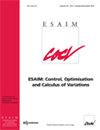New results concerning the hierarchical control of linear and semilinear parabolic equations
IF 1.2
3区 数学
Q4 AUTOMATION & CONTROL SYSTEMS
Esaim-Control Optimisation and Calculus of Variations
Pub Date : 2022-02-04
DOI:10.1051/cocv/2022011
引用次数: 0
Abstract
This paper deals with the application of multiple strategies to control some parabolic PDEs. We assume that we can act on the system through a hierarchy of distributed controls: with a first control (a follower), we drive the state exactly to zero; then, with an additional control (the leader), we minimize a prescribed cost functional. That means that we invert the roles played by leaders and followers in the recent literature. We study linear and semilinear problems. More precisely, we prove the existence (and uniqueness in the linear case) of a leader-follower couple. Then, we deduce an appropriate optimality system that must be satisfied by the controls and the corresponding state and adjoint states. We also indicate some generalizations to other controls, PDEs and systems. In particular, we establish similar existence and optimality results for hierarchical-biobjective (Pareto-Stackelberg) control problems, where there are two cost functionals and two independent leader controls whose main task is to find an associated Pareto equilibrium and one common follower in charge of null controllability.线性和半线性抛物方程的层次控制新结果
本文研究了多策略控制抛物型偏微分方程的应用。我们假设我们可以通过分布式控制的层次结构对系统进行操作:使用第一个控制(追随者),我们将状态精确地驱动为零;然后,通过一个额外的控制(领导者),我们将规定的成本函数最小化。这意味着我们在最近的文献中颠倒了领导者和追随者所扮演的角色。我们研究线性和半线性问题。更准确地说,我们证明了领导者-追随者对的存在性(以及线性情况下的唯一性)。然后,我们推导出一个适当的最优系统,该系统必须由控制和相应的状态及伴随状态所满足。我们还指出了对其他控制、pde和系统的一些推广。特别是,我们建立了类似的存在性和最优性的层次双目标(Pareto- stackelberg)控制问题,其中有两个成本函数和两个独立的领导控制,其主要任务是找到一个相关的帕累托均衡和一个共同的追随者负责零可控性。
本文章由计算机程序翻译,如有差异,请以英文原文为准。
求助全文
约1分钟内获得全文
求助全文
来源期刊

Esaim-Control Optimisation and Calculus of Variations
Mathematics-Computational Mathematics
自引率
7.10%
发文量
77
期刊介绍:
ESAIM: COCV strives to publish rapidly and efficiently papers and surveys in the areas of Control, Optimisation and Calculus of Variations.
Articles may be theoretical, computational, or both, and they will cover contemporary subjects with impact in forefront technology, biosciences, materials science, computer vision, continuum physics, decision sciences and other allied disciplines.
Targeted topics include:
in control: modeling, controllability, optimal control, stabilization, control design, hybrid control, robustness analysis, numerical and computational methods for control, stochastic or deterministic, continuous or discrete control systems, finite-dimensional or infinite-dimensional control systems, geometric control, quantum control, game theory;
in optimisation: mathematical programming, large scale systems, stochastic optimisation, combinatorial optimisation, shape optimisation, convex or nonsmooth optimisation, inverse problems, interior point methods, duality methods, numerical methods, convergence and complexity, global optimisation, optimisation and dynamical systems, optimal transport, machine learning, image or signal analysis;
in calculus of variations: variational methods for differential equations and Hamiltonian systems, variational inequalities; semicontinuity and convergence, existence and regularity of minimizers and critical points of functionals, relaxation; geometric problems and the use and development of geometric measure theory tools; problems involving randomness; viscosity solutions; numerical methods; homogenization, multiscale and singular perturbation problems.
 求助内容:
求助内容: 应助结果提醒方式:
应助结果提醒方式:


